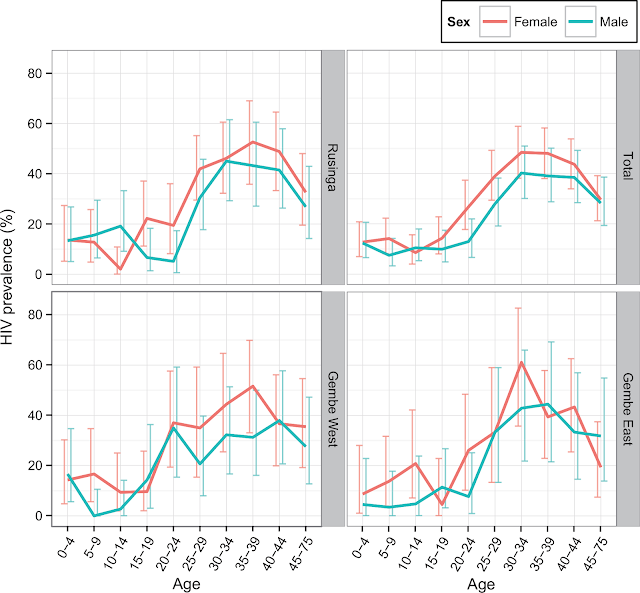HIV is still a major health
problem in developing countries. Even though high HIV-risk-taking behaviors
have been reported in African fishing villages, local distribution patterns of
HIV infection in the communities surrounding these villages have not been
thoroughly analyzed. The objective of this study was to investigate the
geographical distribution patterns of HIV infection in communities surrounding
African fishing villages.
In 2011, we applied age- and sex-stratified random sampling to collect 1,957 blood samples from 42,617 individuals registered in the Health and Demographic Surveillance System in Mbita, which is located on the shore of Lake Victoria in western Kenya. We used these samples to evaluate existing antibody detection assays for several infectious diseases, including HIV antibody titers. Based on the results of the assays, we evaluated the prevalence of HIV infection according to sex, age, and altitude of participating households. We also used Kulldorff’s spatial scan statistic to test for HIV clustering in the study area.
The prevalence of HIV at our study site was 25.3%. Compared with the younger age group (15–19 years), adults aged 30–34 years were 6.71 times more likely to be HIV-positive, and the estimated HIV-positive population among women was 1.43 times larger than among men. Kulldorff’s spatial scan statistic detected one marginally significant (P = 0.055) HIV-positive and one significant HIV-negative cluster (P = 0.047) in the study area.
These results suggest a homogeneous HIV distribution in the communities surrounding fishing villages. In addition to individual behavior, more complex and diverse factors related to the social and cultural environment can contribute to a homogeneous distribution pattern of HIV infection outside of African fishing villages. To reduce rates of transmission in HIV-endemic areas, HIV prevention and control programs optimized for the local environment need to be developed.
In 2011, we applied age- and sex-stratified random sampling to collect 1,957 blood samples from 42,617 individuals registered in the Health and Demographic Surveillance System in Mbita, which is located on the shore of Lake Victoria in western Kenya. We used these samples to evaluate existing antibody detection assays for several infectious diseases, including HIV antibody titers. Based on the results of the assays, we evaluated the prevalence of HIV infection according to sex, age, and altitude of participating households. We also used Kulldorff’s spatial scan statistic to test for HIV clustering in the study area.
The prevalence of HIV at our study site was 25.3%. Compared with the younger age group (15–19 years), adults aged 30–34 years were 6.71 times more likely to be HIV-positive, and the estimated HIV-positive population among women was 1.43 times larger than among men. Kulldorff’s spatial scan statistic detected one marginally significant (P = 0.055) HIV-positive and one significant HIV-negative cluster (P = 0.047) in the study area.
These results suggest a homogeneous HIV distribution in the communities surrounding fishing villages. In addition to individual behavior, more complex and diverse factors related to the social and cultural environment can contribute to a homogeneous distribution pattern of HIV infection outside of African fishing villages. To reduce rates of transmission in HIV-endemic areas, HIV prevention and control programs optimized for the local environment need to be developed.
Below: Study site along the shore of Lake Victoria in Mbita, Kenya
Below: HIV prevalence by sub-area of the study site according to age-group and sex. The horizontal axis indicates age groups in units of five
years, and the vertical axis shows the prevalence of HIV positive cases. Red
and blue lines with error bars indicating 95% confidence intervals represent
females and males, respectively.
Below: The estimated HIV
positive population by sub-area of the study site according to age and sex. The horizontal axis shows five-year
age groups, and the vertical axis shows the prevalence of HIV positive cases.
Red and blue lines with error bars indicating 95% confidence intervals
represent females and males, respectively.
Below: Results of cluster analysis using Kulldorff’s spatial scan statistic for both HIV-positive and negative clusters
Full article at: http://goo.gl/LlLNY1
By:
Tomonori Hoshi, Kenji Hirayama
Graduate School of Biomedical Sciences, Nagasaki University,
Nagasaki, Japan
Tomonori Hoshi, Yoshito Fuji, Chihiro Tanigawa, Satoshi
Kaneko
Department of Ecoepidemiology, Institute of Tropical
Medicine (NEKKEN), Nagasaki University, Nagasaki, Japan
Samson Muuo Nzou, Matilu Mwau, Mohamed Karama
Nagasaki University Institute of Tropical Medicine–Kenya
Medical Research Institute (NUTIM–KEMRI) Project, Nairobi, Kenya
Samson Muuo Nzou, Matilu Mwau
Centre for Infections and Parasitic Disease Control
Research, Kenya Medical Research Institute (KEMRI), Busia, Kenya
Ibrahim Kiche
Thomas Odhiambo Campus, International Centre of Insect
Physiology and Ecology (ICIPE), Mbita, Kenya
Anne Wanjiru Mwangi
Production Department, Kenya Medical Research Institute
(KEMRI), Nairobi, Kenya
Mohamed Karama
Centre for Public Health Research, Kenya Medical Research
Institute (KEMRI), Nairobi, Kenya
Tomonori Hoshi, Kenji Hirayama
Department of Immunogenetics, Institute of Tropical Medicine
(NEKKEN), Nagasaki University, Nagasaki, Japan
Kensuke Goto
National Mental Support Center for School Children Crisis,
Osaka Kyoiku University, Osaka, Japan
Satoshi Kaneko
Nagasaki University School of Tropical Medicine and Global
Health, Nagasaki, Japan
More at: https://twitter.com/hiv insight





No comments:
Post a Comment